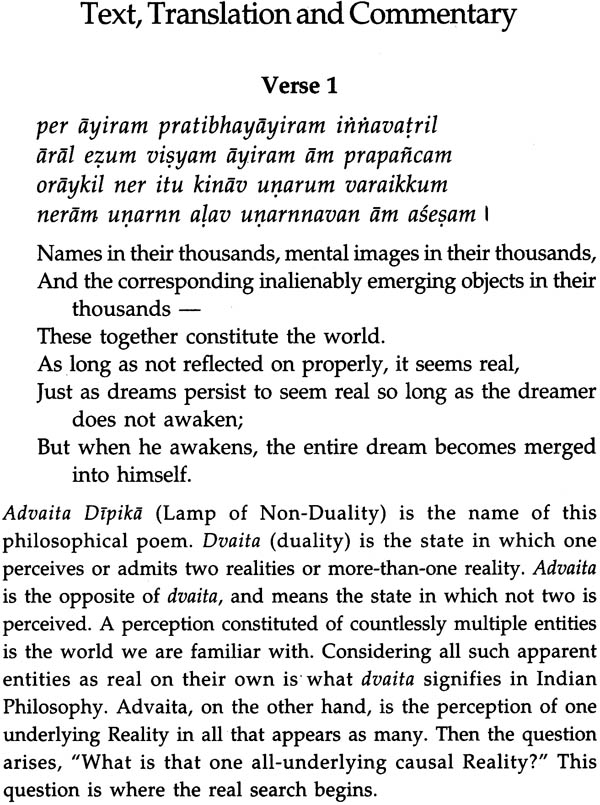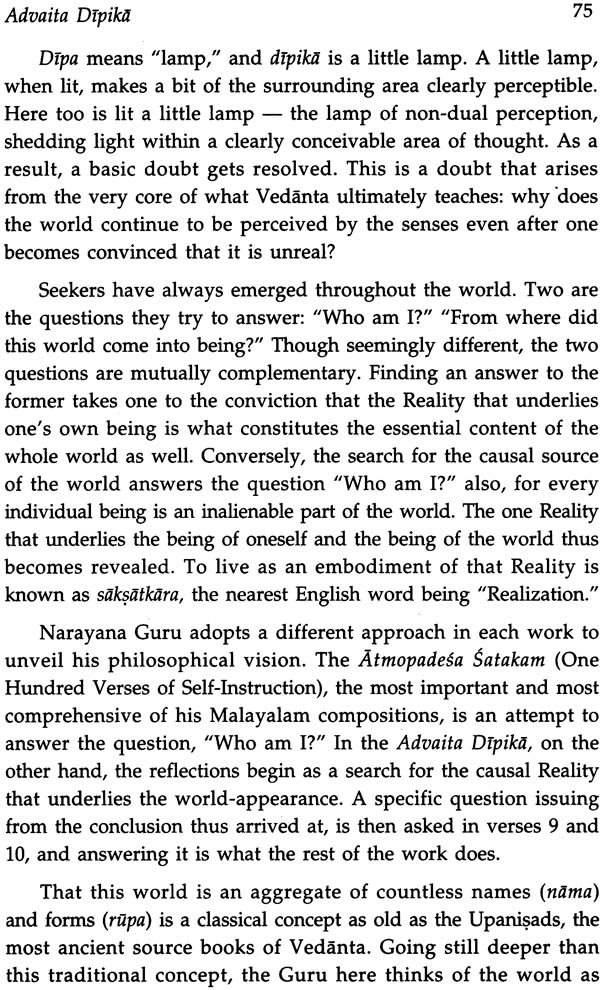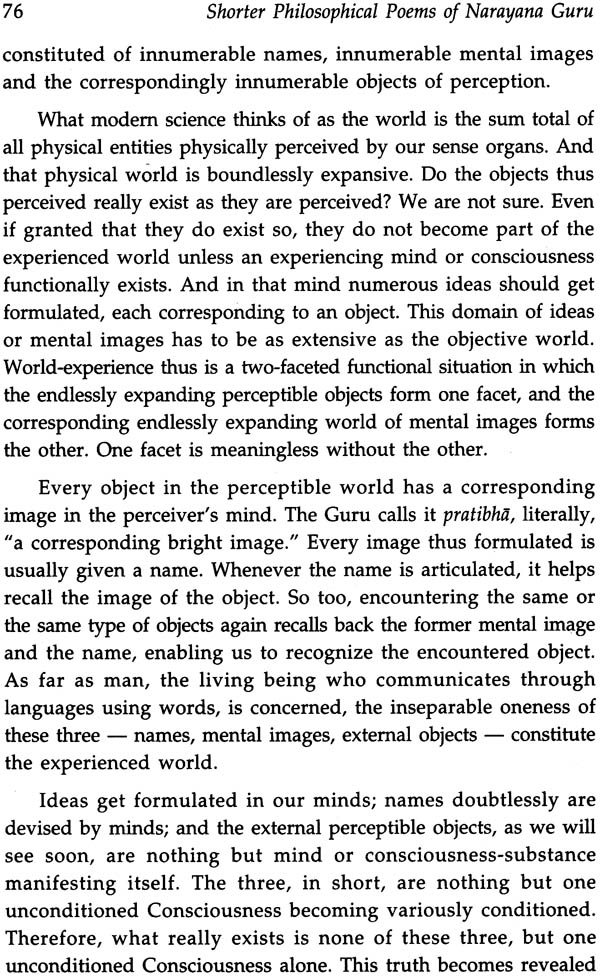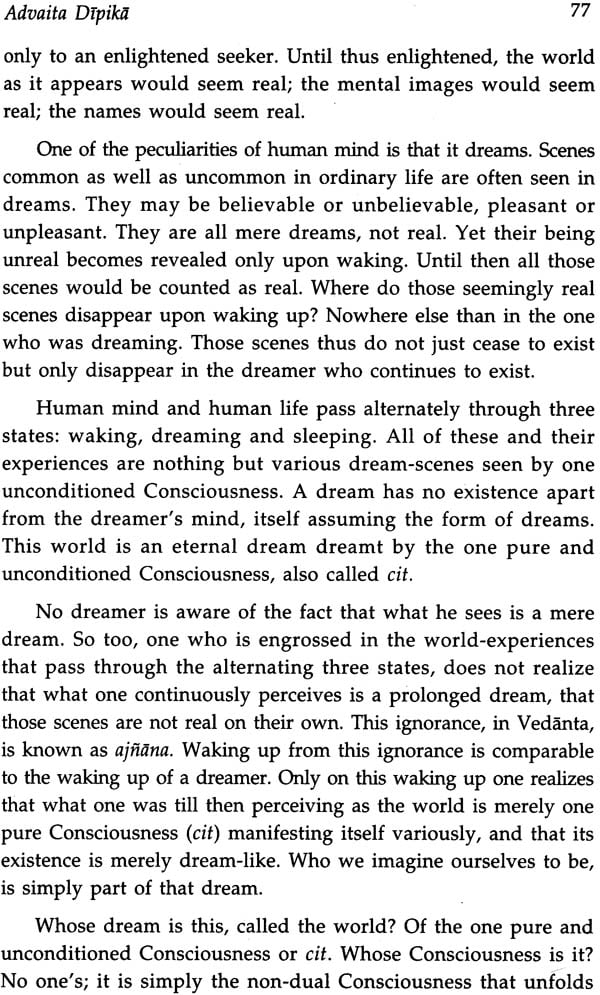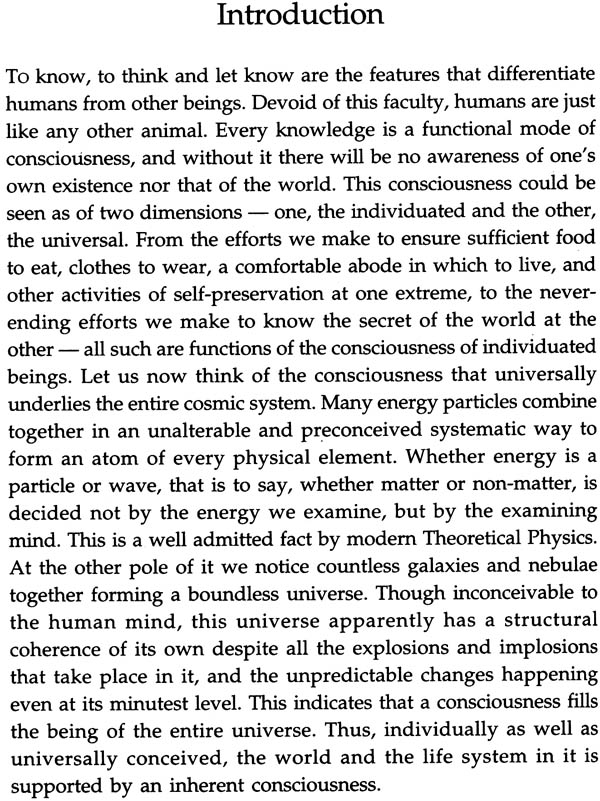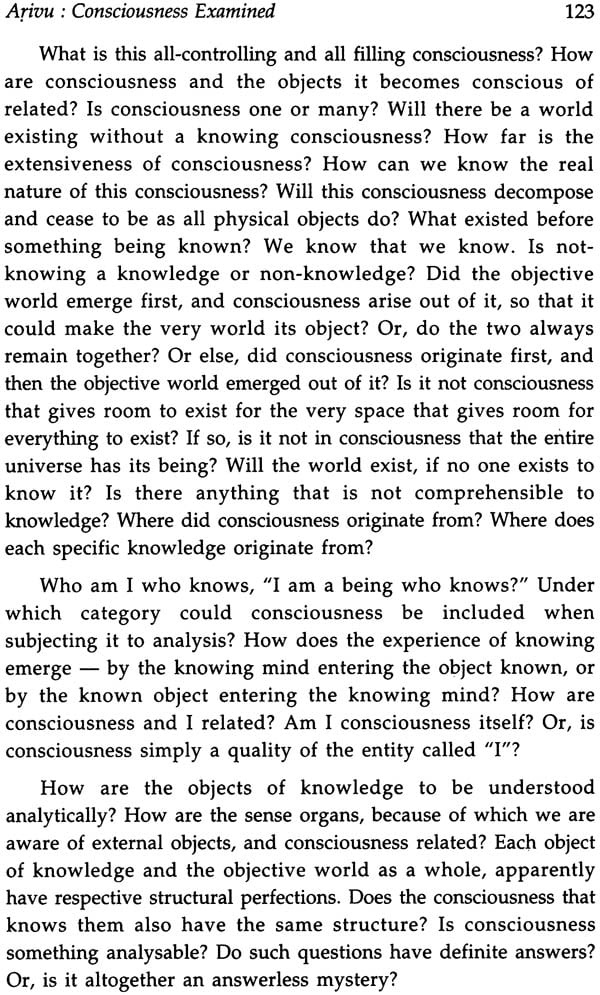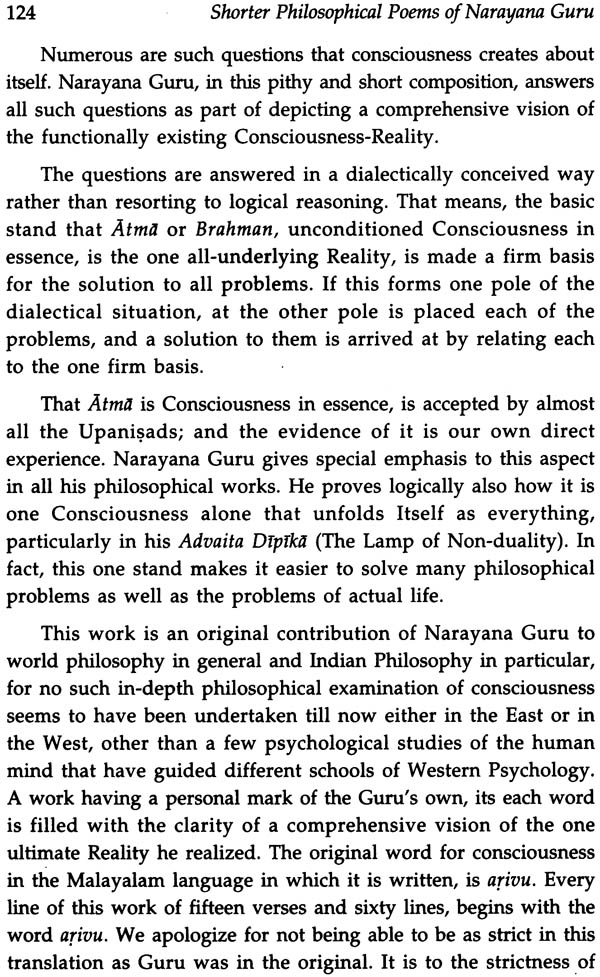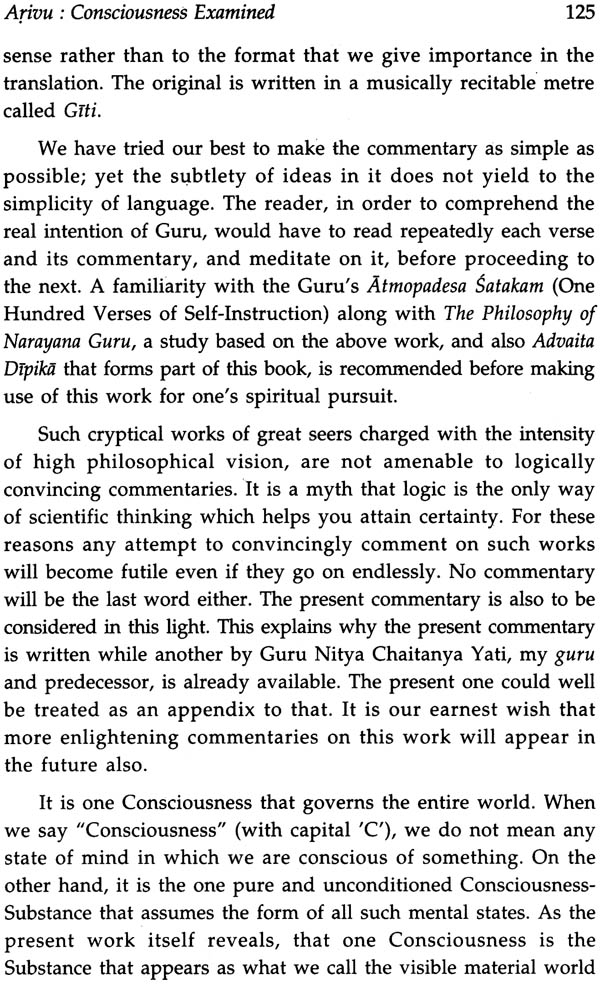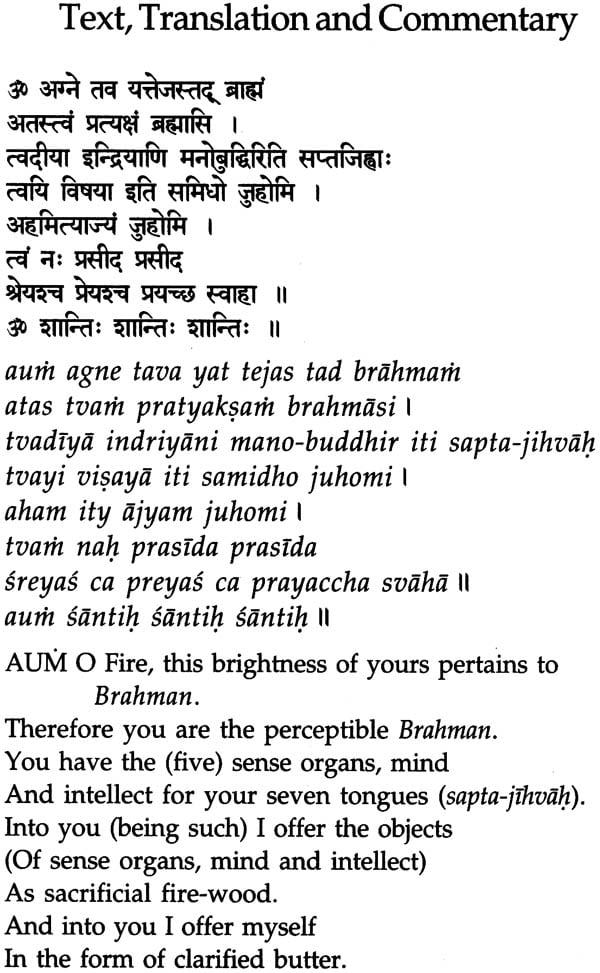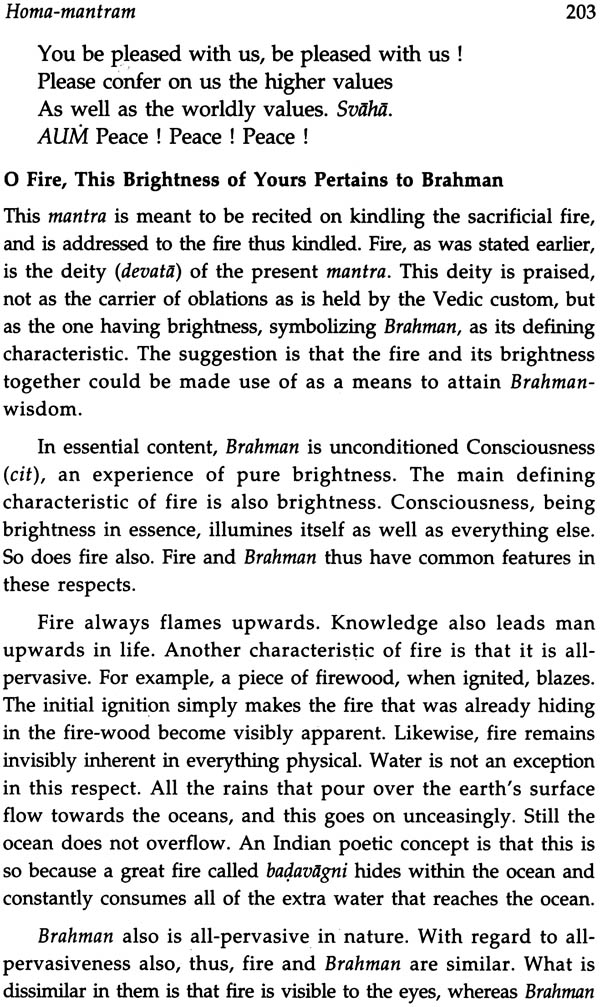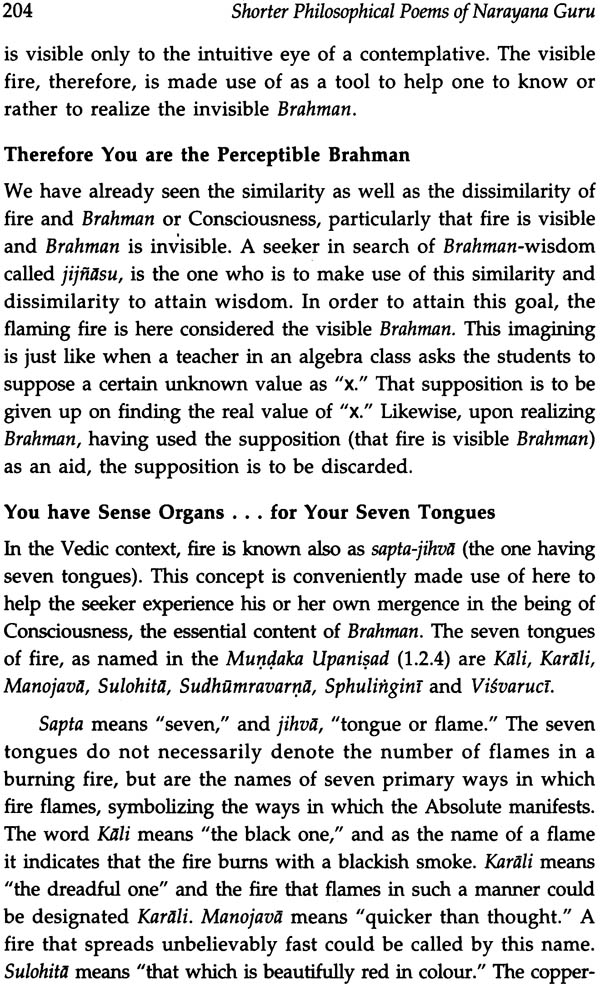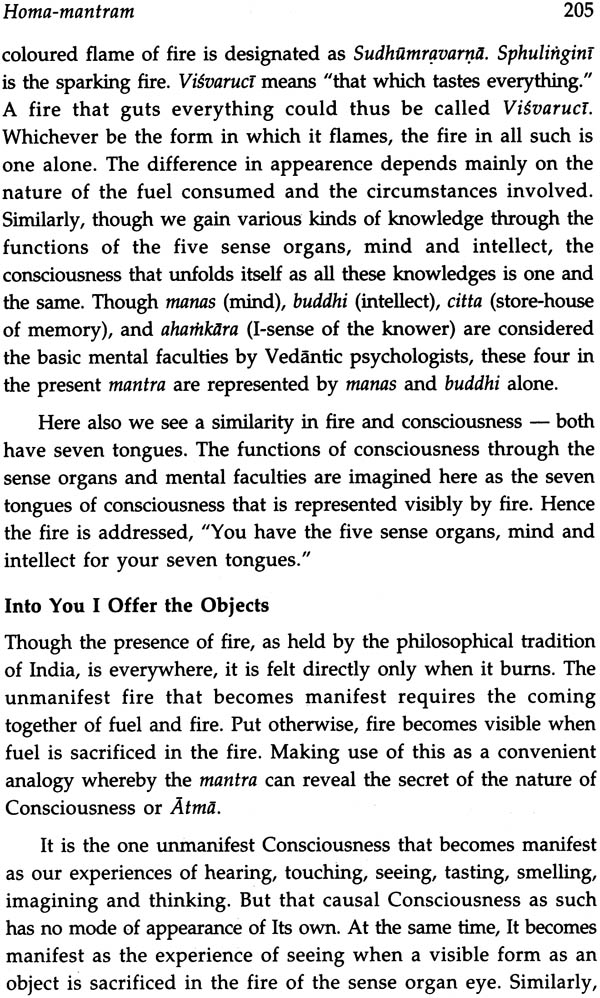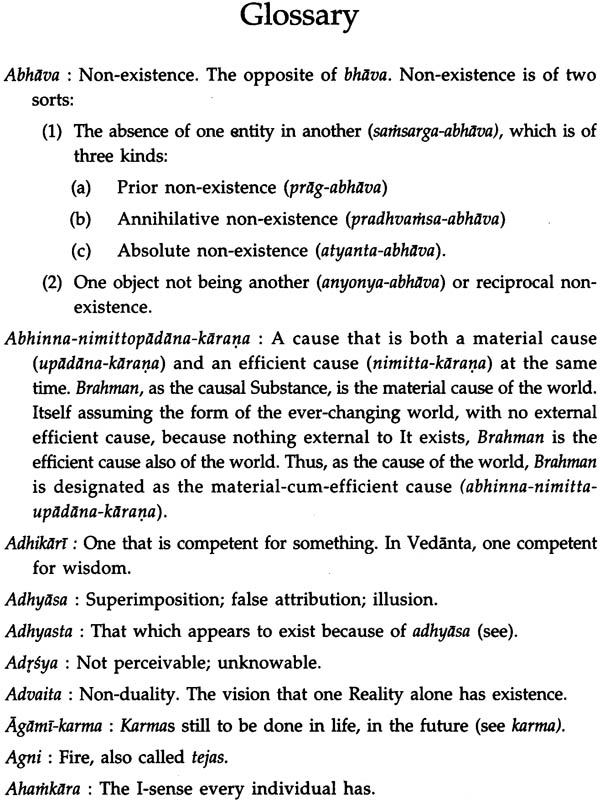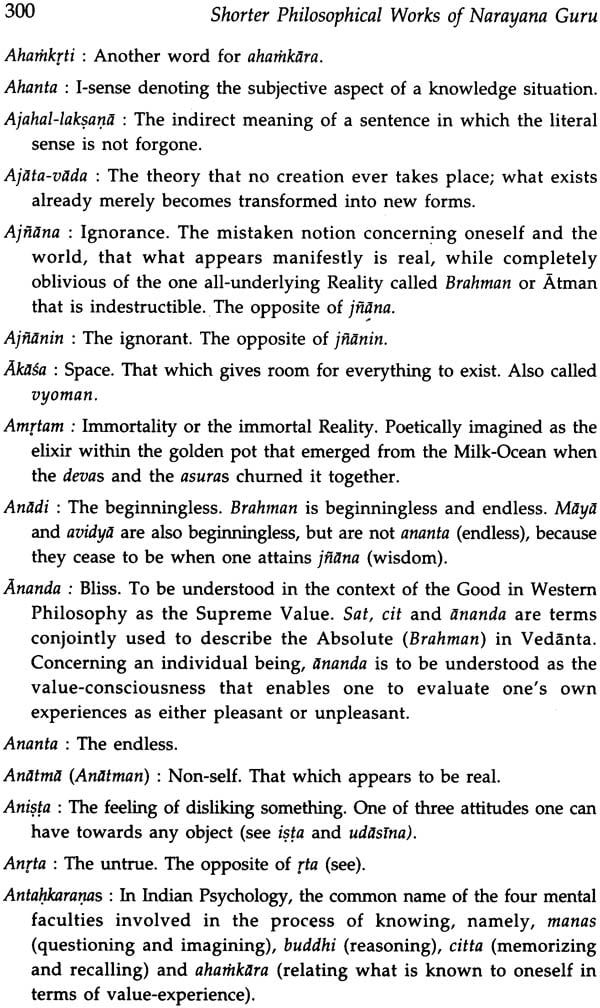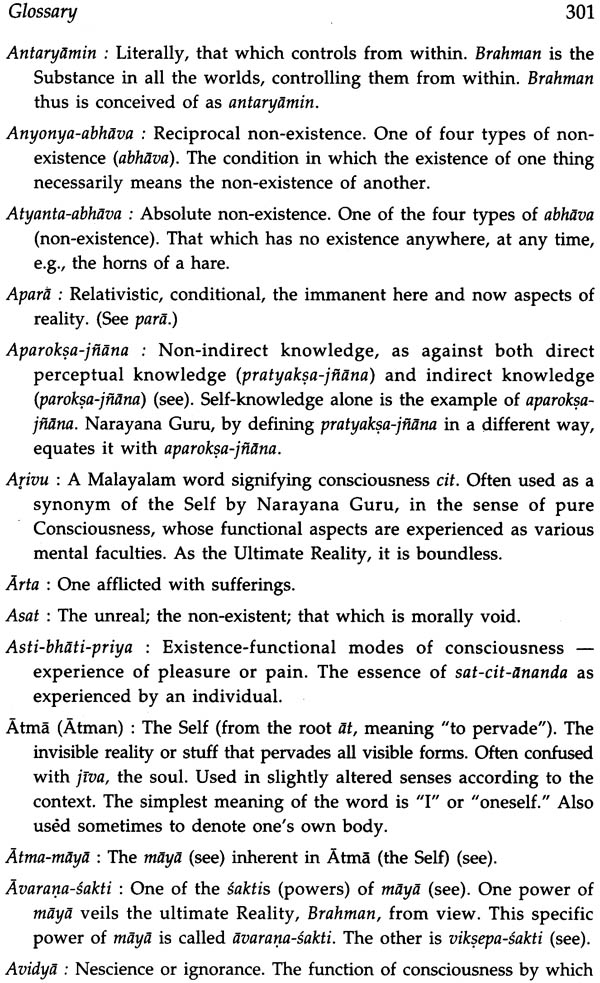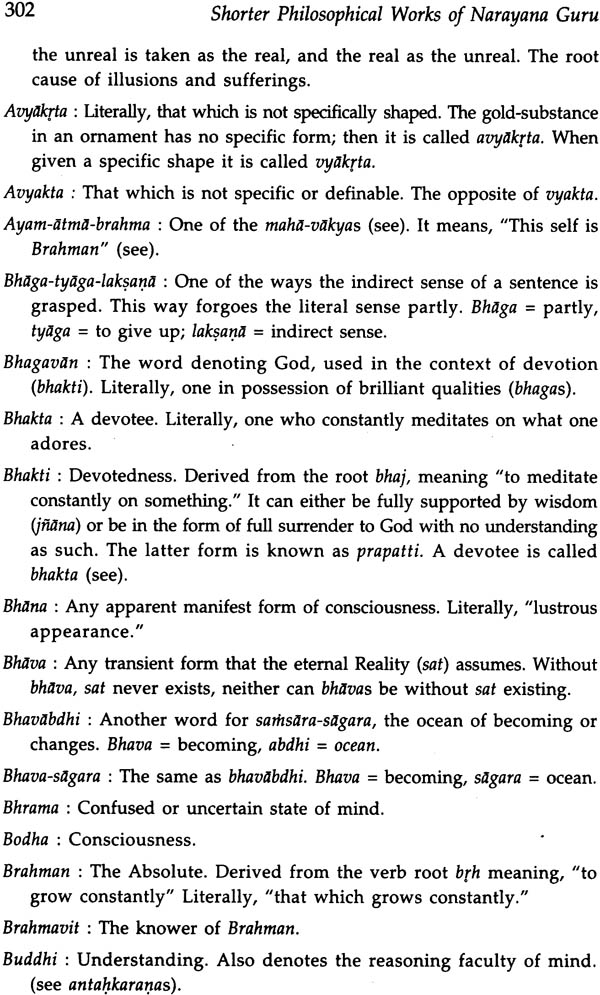
Shorter Philosophical Poems of Narayana Guru
Book Specification
| Item Code: | IHL573 |
| Author: | Swami Muni Narayana Prasad |
| Publisher: | D. K. Printworld Pvt. Ltd. |
| Language: | English |
| Edition: | 2010 |
| ISBN: | 9788124605158 |
| Pages: | 320 |
| Cover: | Paperback |
| Other Details | 8.5 inch X 5.5 inch |
| Weight | 470 gm |
Book Description
Back of the Book
The work collects Narayana Gurus most important shorter philosophic poems into one volume. They are respectively, the Brahmavidya Pancakam (Science of the Absolute), Advaita Dipika (Lamp of Non-Duality), Arivu (Consciousness Examined), Homa Mantram (Fire Oblation) and Daiva Dasakam (Ten Verses Addressing God). The verses are rendered into English and commented upon extensively by Swami Muni Narayan Prasad. Alongside the Guru’s Atmopadesa Satakam (One Hundred Verses of Self – Instruction) and the Darsana Mala (Garland of Visions), these poems are intended to transmit the wisdom of the Upanisads to the earnest seeker of the modern age. As a rsi of the modern age, Narayana Guru deals with issues pertinent today, including how social ethics and other contemporary problems are to be treated in light of the Absolute. As such, the Guru’s poems may be said to both ancient and modern at the same time.
Each poem contained in this book be said to deal a specific philosophical problem or a set of problems that may be encountered in the search for the absolute. Each problem is consistently answered in light of the absolute. Such elucidations include the prerequisites of both a true seeker and a true guru, the nature of the rapport to be established between each, and how the absolute is sat, cit and ananda together. Other elucidations include the ultimate nature of reality examined in terms of consciousness, how Vedic ritual may be understood properly so that it may lead one to the highest realm of non – dual wisdom, and how to pray to God in the absolutist sense.
Swami Muni Narayana Prasad is the Guru and Head of Narayana Gurukula, a guru-disciple foundation open to all, irrespective of caste, creed, gender, religion or nation, aimed at promoting the science of the Absolute (Brahma-vidya) as restated by Narayana Guru. A disciple of Nataraja Guru and Guru Nitya Chaitanya Yati, he has traveled widely teaching Indian philosophy. He has authored around seventy-five books in the Malayalam language. His English books are: commentaries on the Isa Kena, Katha, Prasna, Mundaka, Mandukya Taittiriya, Aitareya and Chandogya Upanisads, Vedanta Sutras and Reincarnation, Basic Lesson on India’s Wisdom, The philosophy of Narayana Guru, Life’s Pilgrimage through the Gita, Collected Works of Narayana Guru, Narayanasmrtih and Natural Philosophy for Youth.
NARAYANA GURU is mostly known in India for his activities for the upliftment of the socially downtrodden, especially the oppressed class. In truth, his concern was not merely for the downtrodden, but for the human race as a whole. This concern of his was not as an active humanist, but as an enlightened seer who was the embodiment of the Upanisadic wisdom. The clarity of his vision of Reality was such that he could revalue and restate that wisdom making it comprehensible to the mindset of the Age of Science. The oneness of Reality is what this wisdom reveals. A seer of this Reality cannot but perceive the human race as of one species, and all humans as equals. Any inequality among humans, then, based on caste, social status or other prejudices, is unjustifiable. He therefore stood against all such discriminations, and thus could be seen as working for the cause of the downtrodden. Of course, the people belonging to the lowest stratum of the society benefited much from the Guru. This should not belittle the sublimity of the wisdom he taught directly to his closest disciples, and put on record in his sixty philosophical poems.
An English translation of the complete works of Narayana Guru was recently published by the National Book Trust, India. He gives precise expression to his philosophical vision in his major works Atmopadesa Satakam (One Hundred Verses of Self- Instruction), Darsanamala (Garland of Visions), Vedanta-Sutra and in the five shorter works commented on in this volume. The commentaries on these major works have already been published by Messrs D.K. Printworld, New Delhi. Another book, summarizing the Guru’s philosophy entitled The Philosophy of Narayana Guru, has also been brought out by them. With the publication of the present volume, commentaries on all the philosophical works of Narayana Guru have now become available in English. What remains to be published are the same kind of commentaries on his highly poetical hymns that also contain sublime philosophical insight. Though the commentaries on these works are already available in the Malayalam language, I feel doubtful how far I’ll be able to render all of these into English. It seems therefore better for me to leave it for others to do. Having been able to translate and publish all the original works into English makes me fully satisfied.
As a long time friend of the Gurukula, Dr Peter Oppenheimer took much pain to go through these commentaries, carefully editing them.
Messrs D.K. Printworld have shown much interest in bringing out these commentaries, along with ones on the Upanisads and the Bhagavad-Gita—Gita, and some other important works. l appreciate their sticking to the idea of publishing scholarly works alone. l wish their endeavour the best.
It is the philosophical insight given by Nataraja Guru, the wisdom-successor of Narayana Guru, and also by his successor and my predecessor in the Narayana Gurukula heirarchy, Guru Nitya Chaitanya Yati, that helped me muster the courage to write these commentaries. By prostrating at the feet of these direct gurus and above all of Narayana Guru, I offer these commentaries as my flowers of worship.
NARAYANA Guru was a philosopher-saint who lived in the modern State of Kerala in South India. He was also a formidable inspiration behind the social revolution that Kerala underwent in the first half of the twentieth century.
After his higher education in Sanskrit, he left home and walked all over South India as a seeker, leading the pattern of life of a wandering mendicant. This stage of life came to an end as he began his intense process of seeking the Self; undergoing intense disciplines of meditative austerity (tapas), in a cave at the top of a hill called Maruttvamala near Kanyakumari at the tail—end of the Western Ghats. Later he moved to a cave at Aruvippuram on the banks of the river Neyyar, about 70 km north of Maruttvamala. He attained enlightenment, as is presumed, when he was at Aruvippuram. Even though he began his literary career as early as his student hood days, his most important philosophical work Atmopadesa Satakam (One Hundred Verses of Self—Instruction) was composed at Aruvippuram. A description of enlightenment in the above work and quoted below must be considered as an exposition of his own mystical experience:
Like ten thousand suns rising all at once
Dawns the discriminative enlightenment.
That really is the original sun that cuts through
The ephemeral maya-darkness that puts a veil
Over the pure and unconditioned Consciousness.
He founded an asrama at Aruvippuram and installed a Siva temple there in total disregard of the prevailing religious custom that brahmanas alone were entitled to perform such a rite. It was the strength of his wisdom that made him bold enough to do so. Later he established asramas at Varkala and Aluva also. Varkala, in course of time, became the centre of the spiritual movement initiated by him.
Inspired by his daringness to install a temple—deity, people all over South India approached him with demands for more such temples at numerous places. He readily complied with their wishes and the outcome was the coming into being of nearly eighty temples, all allowing everyone to enter. The existing orthodox temples allowed only cases Hindus to enter the temple and offer worship. In some cases he wrote hymns praising the deity of the temple, as a method of instruction on how people should understand that particular deity, and idol worship in general.
His uncompromising stand against casteism; and the bold messages he gave to his followers, resulted in a social transformation of long—standing effect, particularly in the state of Kerala. He also influenced the National Freedom Movement that was at its peak at that time, through the correction he gave to the caste—concepts of Mahatma Gandhi during one of the Mahatma’s visits to the Guru.
All these social transformations were a sort of applied aspect or rather a reflection of his philosophy of oneness, in human affairs. He thought that philosophy must ensure happiness to a person in his/ her personal and social life, and must be made use of to do away with all that is wrong in life.
Though avowedly a follower of Sankara’s Advaita philosophy, he was not simply restating what Sankara and his followers said on Vedanta. He did not write any commentary on the canonical texts of Vedanta - the Upanisads, Bhagavad—Gita and Brahma-Sutras, - as Sankara did. Instead, he wrote original works on Vedanta as profound as the Upanisads and as precise as modern textbooks on sciences. He wrote even a new text named the Veddr1ta—SiYtr¢1s. Narayana Guru’s contribution, thus, was a revalued restatement of non.-dualism.
The Guru, in re—presenting Vedanta with such a new tone, instead of resorting to traditional methods, adopted his own new ones that could accommodate the modern minds of the Age of Science, while not compromising the originality and purity of the mystical content of the philosophical visions the Upanisads portray. The strictness of philosophical speculation, the precision natural to the Age of Science, and the sublimity of mystical vision — all these could be seen in harmony in the Guru’s philosophy, each forming a formidable prop for the others. Here and_ there we come across certain corrective touches given to Vedanta, and also the avoidance of many subtle epistemological problems arising from cumbersome methods.
His literary works can be classified into five as hymns, philosophical works, works of moral import, translations and prose works. Spread out in three languages •— Malayalam, Sanskrit and Tamil - his hymns are thirty—one in number. They praise the deities Vinayaka, Visnu, Siva, Devi and Subrahmanya, all with a poetically sublime touch of non-dualism.
Atmopadesa Satakam (One Hundred Verses of Self—Instruction), Darsana Mala (Garland of Visions), Brahmavidya Pancakam (The Science of the Absolute in Five Verses), Advaita Dipika (Lamp of Non-Duality), Arivu (Consciousness), and Daiwa Dasakam (Ten Verses Addressed to God — A Universal Prayer) are his philosophical works. His translations are from Sanskrit or Tamil originals to Malayalam — e.g. Isa Upanisad, part of Tirukkural —and one single verse from Sanskrit to Tamil. All prose works were written in an earlier stage of his life and are reflective of a meditative mood in the Guru.
Of the two major philosophical works, Atmopadesa Satakam, originally in Malayalam, was commented on both by Nataraja Guru and his disciple Nitya Chaitanya Yati. The latter actually wrote two commentaries — an extensive one entitled That Alone — The Core of Wisdom and the other, a series of meditations on its one hundred verses, under the title Neither This Nor That . . . But Aum, both published by Messrs D.K. Printworld. The essentials of its philosophy was codified and brought out by the present commentator in the format of a textbook entitled The Philosophy of Narayana Guru, published again by D.K. Printworld.
Darsana Mala, in the Sanskrit language, is written in an idiom familiar to traditional Vedantins. Yet it adopts a novel method of presentation hitherto uncharted by any philosopher anywhere in the world. This method is that of perceiving and examining the one non—dual Reality from different perspectives in such a way that from each vision the contemplative eye of the seeker could intuitively perceive what the Guru intended to communicate. Adhyaropa (Superimposition), Apavada (Methodic Refutation), Asatya (Non—existence), Maya, Bhana (Manifestation of Consciousness), Karma (Actions), Jnana (Knowledge), Bhakti, Yoga and Nirvana are the ten vantage points from which the non—dual Reality is viewed in the ten chapters of this composition.
Nataraja Guru, the wisdom—successor of Narayana Guru, interpreted this work showing it could serve as a firm foundation for formulating a Science of sciences or the Science of the Absolute, in a magnum opus which was published in two volumes. Nitya Chaitanya Yati, Nataraja Guru’s successor, wrote yet another commentary on it revealing the psychological implications of this work, under the title Psychology of Darsana Mala. The present commentator also wrotea commentary, named Garland of Visions, expounding how the Vedantic non—dual vision becomes revealed in this text. All these commentaries are published by Messrs D.K. Printworld.
The Vedanta-Sutras is the first sutra-text on Vedanta written since the unknown time of the ancient Badarayana who wrote the first Vedanta—Sutras or Brahma-Sutras. A major part of this ancient text is set aside to refute other schools of thought and to establish that Advaita (non—dualism) is the philosophy expounded in the Upanisads. Narayana Guru, on the other hand, in his modern sutra—text on Vedanta, clearly expounds in 24 simple sutras (aphorisms) what the essential content of Vedantic teaching is. Perceiving Brahman from the sat point of view and the asat point of view and showing how both lead us to one and the same conclusion, is the method adopted in this work. A commentary on it written by the present commentator has been published again by Messrs D.K. Printworld.
The present volume is a compilation of commentaries on the five shorter philosophical poems of the Guru, namely Brahmavidya Pancakam (The Science of the Absolute in Five Verses), Advaita Dipika (Lamp of Non-duality), Arivu (Consciousness Examined), Homa Mantram (Chants for Oblation in Fire), and Daiwa Dasakam (Ten Verses Addressed to God — A Universal Prayer).
Brahmavidya Pancakam is a short composition of five verses in the Sardula-vikriditam metre, written in the traditional style, but with the Guru’s new touches of revision. The first verse states the prerequisite qualities of a true seeker, who is a true guru, the importance of the rapport between the guru and the disciple, and what are the philosophical questions a disciple supposedly asks. The second verse gives the most direct answer to the question in the words, "You are Brahman indeed/’ and how you are not anything else. The next three verses expound in the guru's own way how Brahman or oneself is sat (Existence) in essence, cit or pratipat (both meaning "Consciousness") in essence, and ananda (Value experience) in essence repectively.
Advaita Dipika is a Malayalam poem in the Vasantatilakam metre. In the beginning of its nineteen verses, the Vedantic doctrine is elucidated in terms of causality, that is to say, that cause alone has real existence and the apparent existence of effects is illusory. Then a question arises: why does the apparent world continue to appear to be real even after one becomes fully convinced of its illusoriness? This problem, raised at the very middle of the composition, is answered in the rest of the poem. It seems, this problem has never been raised by Vedantins before nor answered tellingly as the Guru does here, shedding more light on the finality of Vedanta.
Arivu, a unique composition, is an original contribution of Narayana Guru to world philosophy. The word arivu means consciousness or knowledge. An important element in the philosophy of Narayana Guru is the special emphasis he gives to the Reality or /ltuu7 being Consciousness in essential content. This peculiarity helps avoid many of the epistemological problems Sankara tries to wade through in various contexts of his commentaries. We have tried to clarify this point in our The Philosophy of Narayana Guru.
Written in the Giti metre, its fifteen verses elucidate how everything is but one Consciousness in essence, how you are also the very same Consciousness, and how one unconditioned Consciousness, in its conditioned states, assumes the subjective and objective aspects of appearance, with a strict parity between the two. It could also be said, this work is an exposition of Vedanta as pure epistemology in the strict sense of the term, i.e., the science of consciousness. Nataraja Guru evaluates this work as "a masterpiece of contemplative workmanship unrivalled in literature anywhere."
The Guru composed the Homa Mantram on an occasion in which he was visited by Swami Sraddhananda, then a senior samnaysin of the Arya Samaj. During the visit the Guru and the Swami came to discuss at length the greatness of Vedic fire—sacrifices. In the course of their conversation, the Guru asked, "Why shouldn’t we perform such a fire-sacrifice here?" The Swami liked the idea, and so the following morning everything was prepared for the event. But just before the fire-sacrifice was ready to commence, Guru handed the Swami a piece of paper while asking, "Couldn’t we perform the homa by chanting this mantra?" Upon examining the contents scrawled upon the paper, the Swami, to his surprise, found a mantra nowhere to be found in the Vedas. That is because it was in fact a new homa mantra, composed by the Guru himself. This new mantra revealed how the fire—sacrifice itself could be utilized to teach the non—dual Wisdom. By using such an ancient ritual, so deeply imbedded in Indian culture, the Guru showed his talent for wasting no opportunity to teach the Wisdom secret.
Daiwa Dasakam, in the Anustubh metre, though in the format of a prayer, contains the entire philosophy of the Guru represented in a poetical idiom. Prayer, in the usual course, is a religious practice; this is no exception. Still it is not possible to limit it to the confines of any particular religion. Rather it is a universal prayer. How it is so, is made amply clear in our commentary. Though not strictly a philosophical work, it is also included in this volume, as it helps the reader form a clear picture of the Guru’s philosophy and how he perceives life.
India’s wisdom tradition is a hoary one, and time and again it has been restated by various masters of many epochs, systematizing it in different ways, but all clinging to a traditional Indian way of presentation. Restating the same wisdom in modern terms, imbibing fully the spirit of the mindset of the modern Age of Science, is a need of the day. This, to a great extent, we feel, has been accomplished by Narayana Guru. Such a revised restatement of India’s wisdom elevates itself to the status of a formidable world philosophy, or a Science of sciences in which physical science and metaphysical science find a common ground. The emergence of such a Science, or rather philosophy, is the need of the age, especially when mankind tends to be strife-ridden either in the name of religion or politics instead of finding their unity. Only the wisdom of the masters of the cadre of Narayana Guru can lend at least a straw of hope to mankind in the days to come. Such resurrection for the world would be possible only if we could reinterpret the hoary wisdom-traditions of mankind in terms comprehensible to the modern Age of Science, cutting across the barriers of nations and religions. Such a restated philosophy would be a science as well. It is with such an aspiration that we present the philosophy of Narayana Guru through our commentaries.
| Preface | v | |
| Introduction | 1 | |
| 1. | Brahmavidya Pancakam (The Science of the Absolute in Five Verses) | 9 |
| Introduction | 10 | |
| Text, Translation and Commentary | 12 | |
| 2. | Advaita Dipika (Lamp of Non-duality) | 71 |
| Introduction | 72 | |
| Text, Translation and Commentary | 74 | |
| 3. | Ariva (Consciousness Examined) | 121 |
| Introduction | 122 | |
| Text, Translation and Commentary | 127 | |
| 4. | Homa Mantram (Chants for Oblation in Fire) | 193 |
| Introduction | 194 | |
| Text, Translation and Commentary | 202 | |
| 5. | Daiva Dasakam (Ten Verses Addressed to God) | 211 |
| Introduction | 212 | |
| Text, Translation and Commentary | 226 | |
| Glossary | 299 | |
| Index | 315 |
